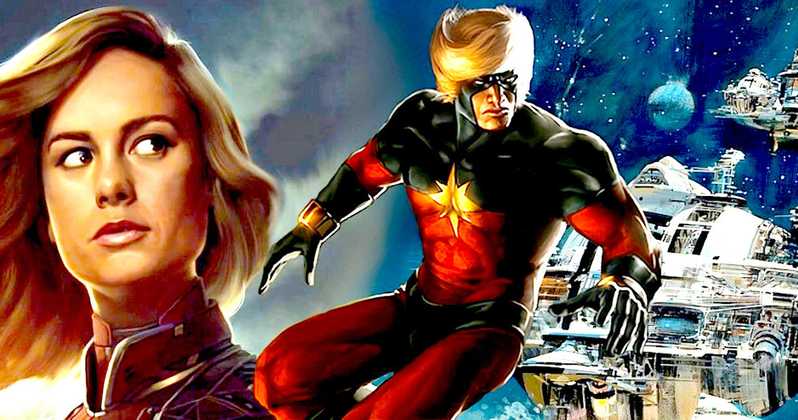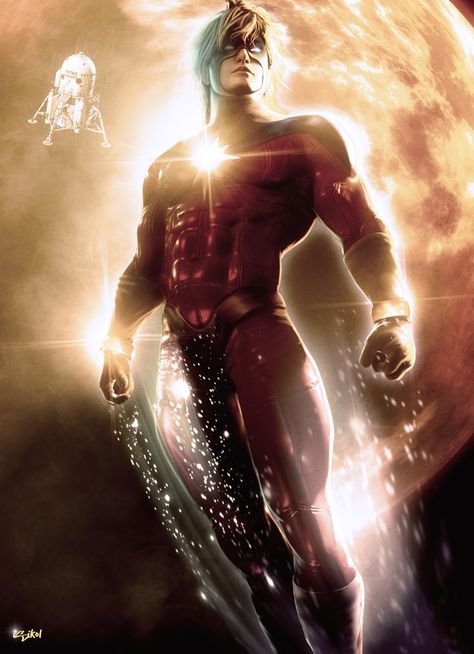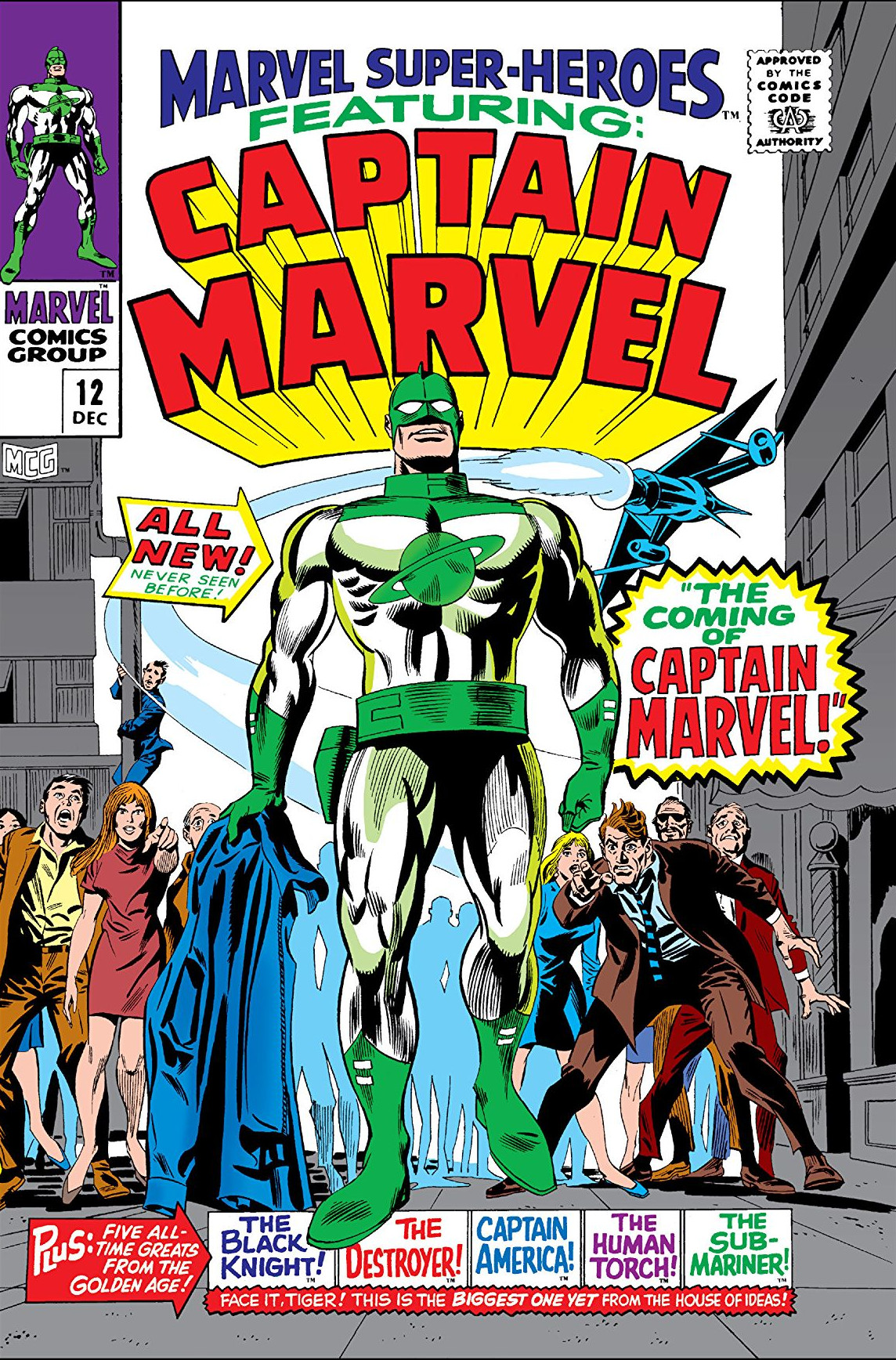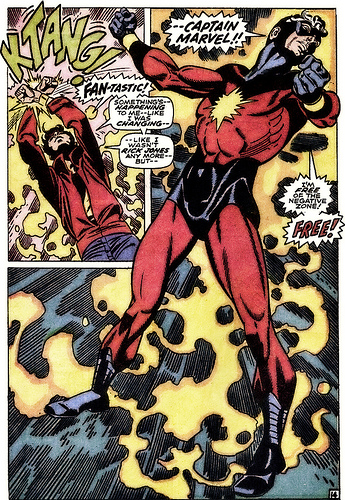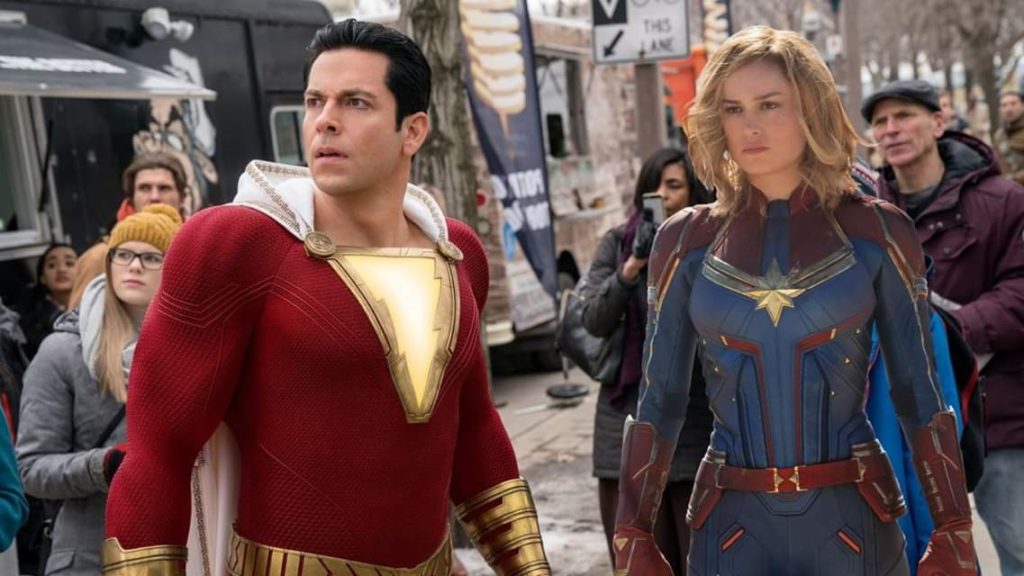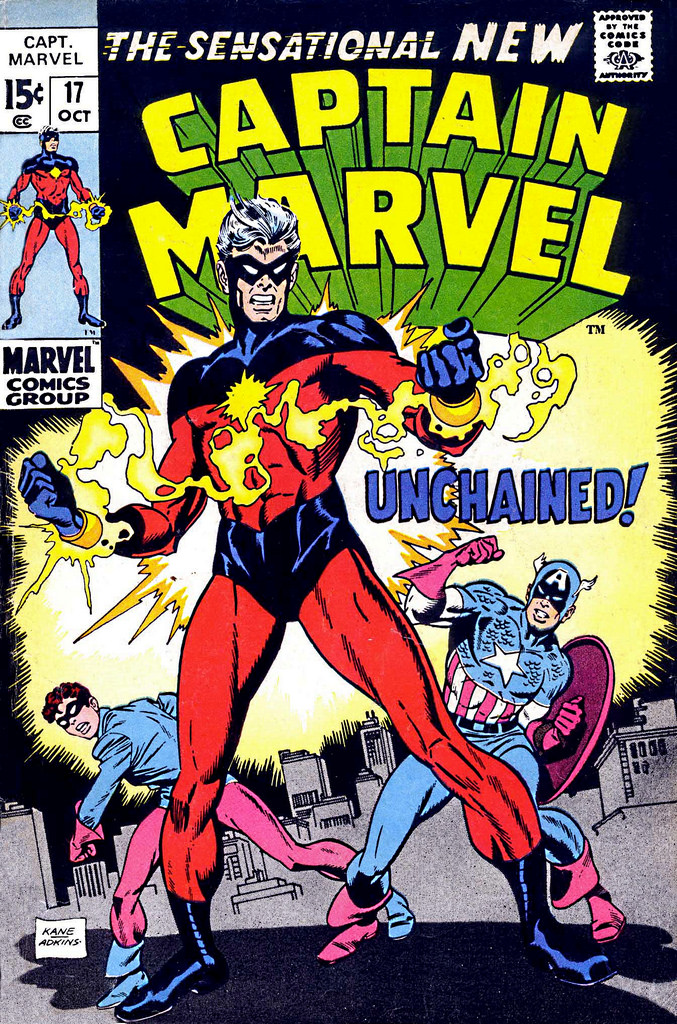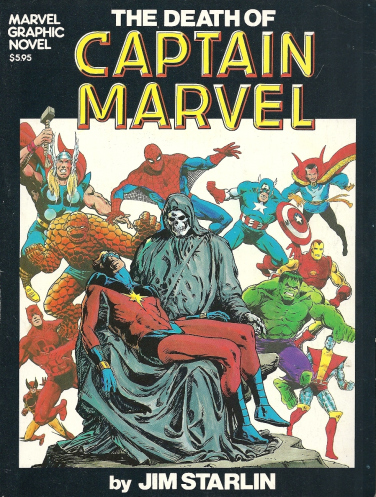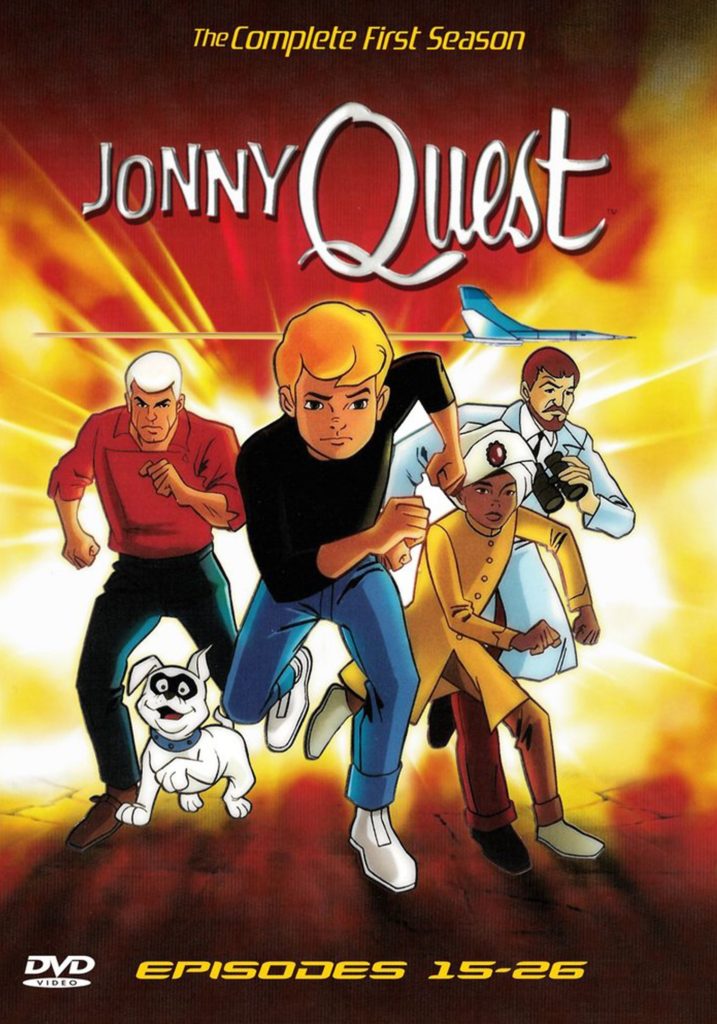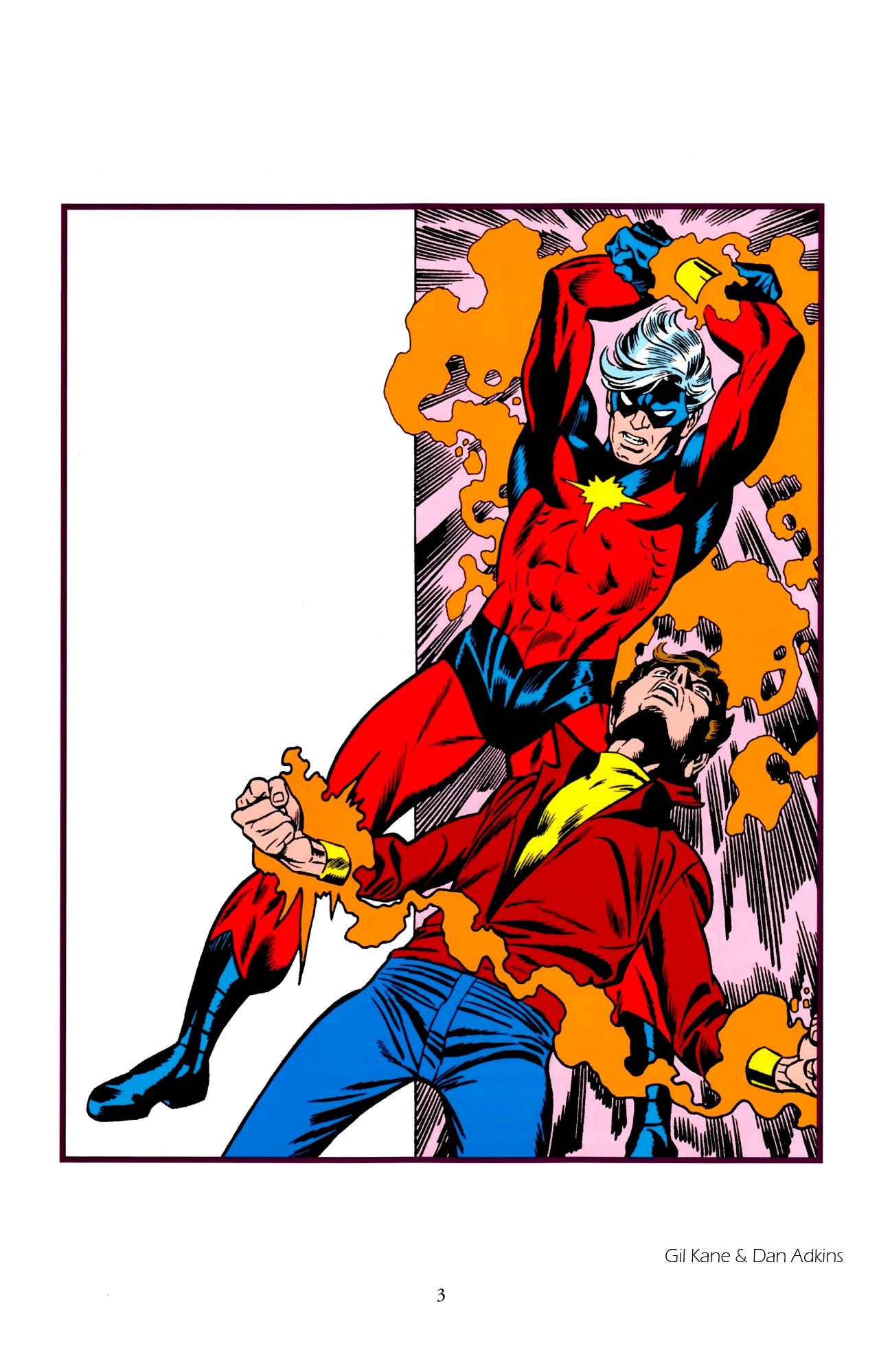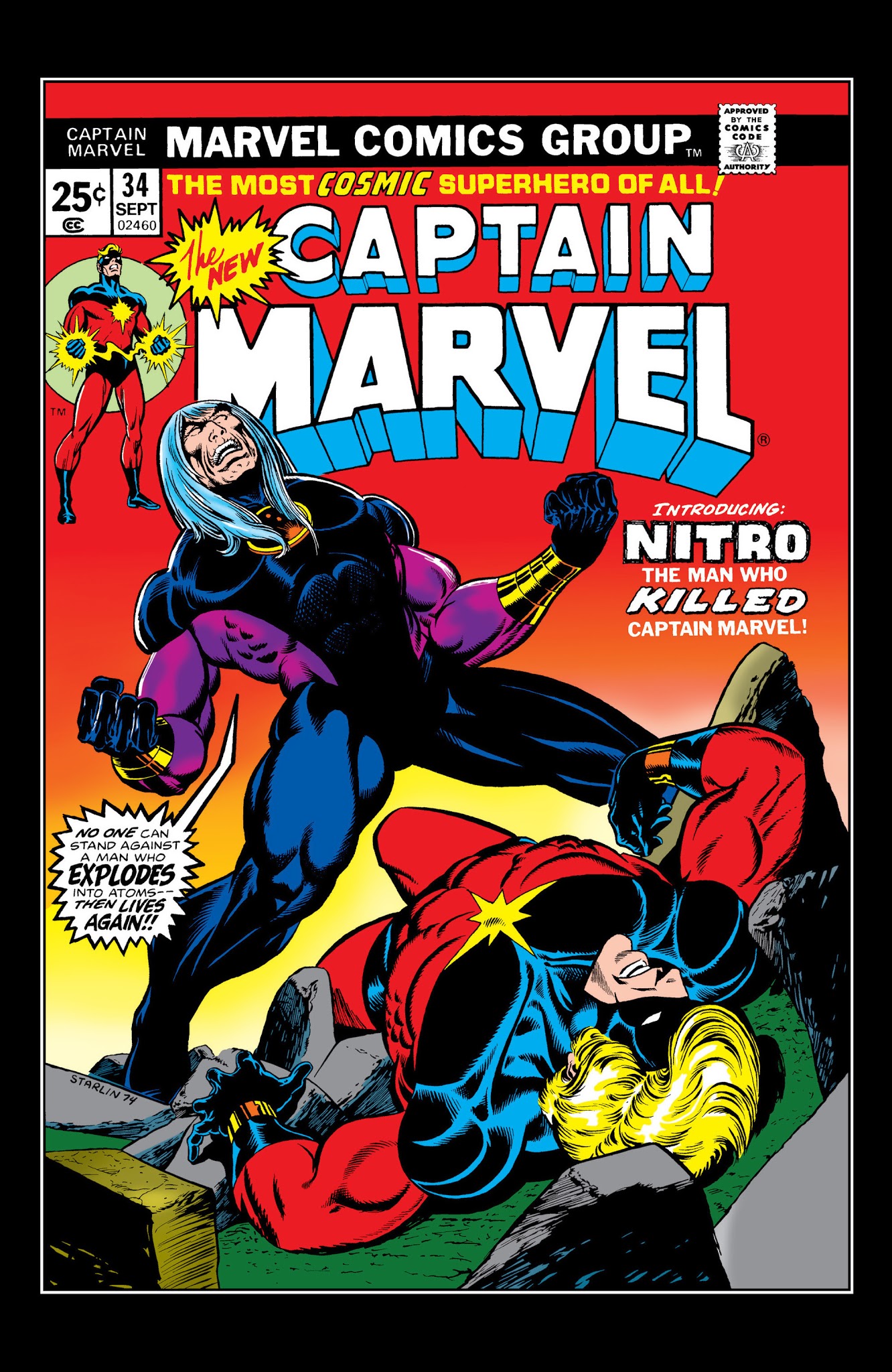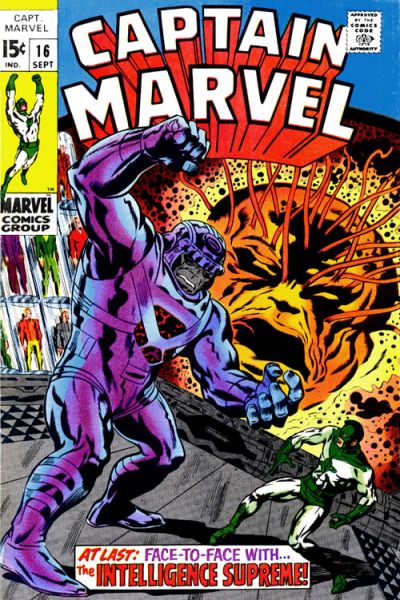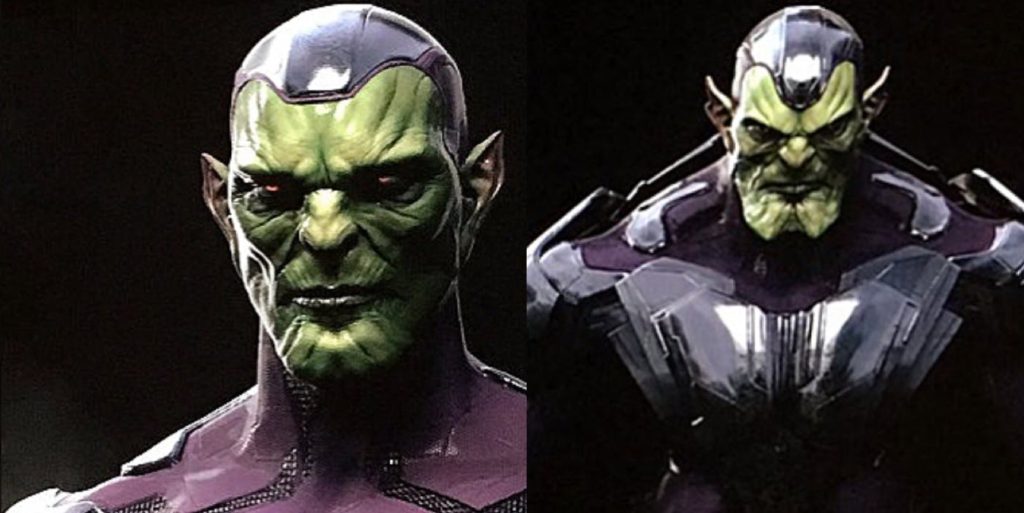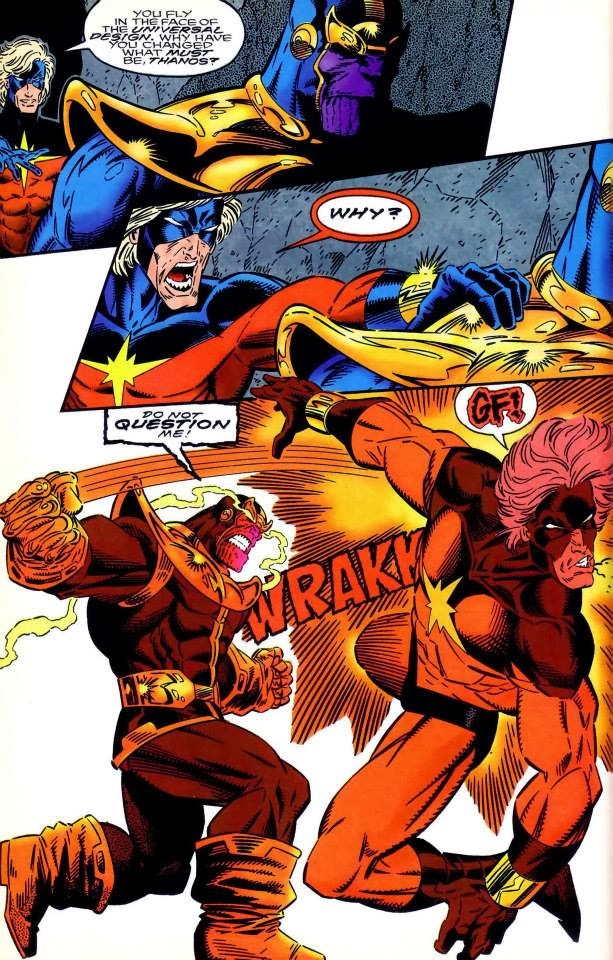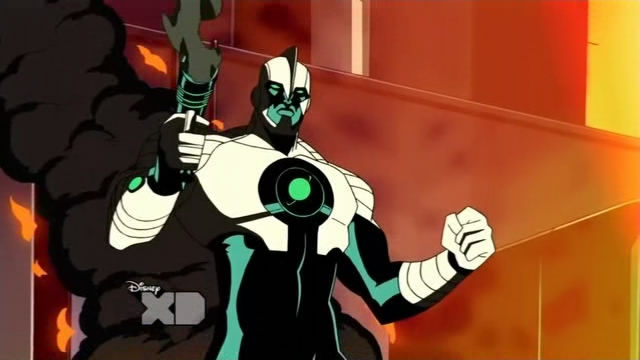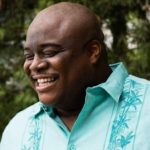
@TheBelser
Welcome my friends to the third part of The Saga of Captain Marvel. Today, your main man “The Belser” is going to be exploring the history of Marvel Comics version of Captain Marvel. Truth be told, I’m a bit biased when it comes to this character because he is my all-time favorite superhero. hopefully this article to give you an insight as to why he is so important and why I feel he is probably the most underrated Marvel character.
How I Found the Character
Around 2004, I was still a young Hospital Corpsman in the US Navy. I was just transferred to Camp Pendleton in Oceanside California to complete what was then known as Field Medical Service School. This would mean my job will allow me to serve with the Marines in various theaters. While exploring the new-found town of Oceanside, I came across a small comic shop that was located directly across the Regal Cinema in downtown Oceanside. While checking out their selection, I kept noticing one graphic novel. It was entitled The Life and Death of Captain Marvel by Jim Starlin.
What caught my eye initially was its cover, which shows a hero laying over dead in the lap of what appear to be the Grim Reaper. At this point, I had never seen or heard of the character before and that intrigued me. I bought it as sort of just an experiment to see if it was something worth checking out. Fortunately for me, it grabbed me from the beginning. I love the artwork and the story and the fact that all these strange cosmic elements were being played out before me. After completing the book, I wanted to know more about this mysterious new space character that I had just come across. For a lifelong fan of franchises like Star Trek, Star Wars and Space Ghost, finding a new space hero was just too good of a deal for me to let go. Since then, that graphic novel has been with me through most of the major events of my adult life. I had the book with me during my year in Japan. I had the book with me during my stint in Iraq. The book was with me when I eventually left the military. Anytime I have a major trip somewhere, I’ll bring the book with me.
Another fact I found to be cool: this is a new hero is not at all new. He had been around for decades. He was created around the same time as the cornerstone Marvel characters like Spider-Man, The Hulk and The X-Men. This character was largely unknown by most of my friends who collected comics and that made him even more special. Mar-Vell became a character that was essentially mine. I didn’t have to share liking him like I would have to with other characters. I have since become a huge advocate for this character. My hope is this article can be used as a definitive guide to a fantastic character that the world has slept on for over 50 years.
Publication History
After acquiring the name Captain Marvel in 1967, Marvel Comics publisher Martin Goodman went to his number one talent, Stan Lee and told him that he wanted Stan to create a version of Captain Marvel for their company. Stan, however, was a bit hesitant seeing as how he remembered the popularity of the original Captain Marvel from Fawcett Comics and did not want to rehash an old idea. It seems he must’ve been basically told ‘I don’t care if you don’t want to do it. Make me one anyway’. In my research for this article, I tried to look up any interview Stan Lee made about the character’s creation.
The late Stan Lee was known to be a bit of a talkative man and had dozens of articles and interviews about many of his other creations (to put it mildly!). To my surprise, I found absolutely none about Captain Marvel. This lack of information confirms that this character was not an organic creation solely from Stan’s mind. It is also notable that Stan Lee only wrote one issue (the character’s debut) and then passed it off to other writers. Anyway, Stan decided his approach to the character would be based in science fiction and technology rather than magic like the original.
Captain Marvel can be seen initially as a pseudo spin-off of the Fantastic Four. At the time, Stan Lee and Jack Kirby had just created a new alien race called the Kree as villains for The Fantastic Four. With the Kree fresh in mind, Stan made one of its soldiers into a hero with a guilty conscience. Instead of a secret identity, he made Captain Marvel the character’s actual name (Mar-Vell). The character debuted in Marvel Superheroes #12, in December 1967.
The Coming Of Captain Marvel
Prior to this, the Kree had two previous encounters with the Fantastic Four. The first is an attack from one of the Kree Sentry robots (Sentry #459) that is stopped by the team. This second encounter came in the defeat of Ronan the Accuser (in his comics’ debut). After these two significant defeats, the Supreme intelligence (or Supremor for short), the leader of the Kree, coordinated a mission to investigate this new crop of superhumans popping up on Earth. This mission is to investigate if humans are the credible threat to the Kree and what their space-faring capabilities were. Captain Mar-Vell is given the assignment to infiltrate Earth due to his status as an elite soldier and the fact that he is a ‘pink’ Kree.
(NOTE: Pink Kree are the result of interspecies breeding and resemble humans much more than the pure ‘Blue’ Kree, who have blue skin).
Mar-Vell joined on the mission by his jealous commander, Colonel Yon-Rogg, and the ship’s medic Una, Mar-Vell’s girlfriend. In an assassination attempt on Mar-Vell, Yon-Rogg ‘accidentally’ fired a laser beam at him, but it destroyed a small private plane instead. The plane’s now dead occupant is named Dr. Walter Lawson. Now comes a series of very convenient consequences for the spy Captain Mar-Vell:
- Dr. Lawson bares an identical resemblance to Mar-Vell (They are basically twins, same hair and everything).
- Due to his advanced alien knowledge, Mar-Vell assumes Lawson’s identity as a ballistic missile expert and robotics scientist.
- Lawson has just been transferred to the nearby military base, Cape Canaveral (near Kennedy Space Center, the real-life home of NASA).
- The Kree Sentry #459 robot (that was defeated by the Fantastic Four) is at Cape Canaveral for research purposes.
- In yet another attempt to assassinate Mar-Vell again, the oh-so-jealous Yon-Rogg activates the Kree Sentry robot to do his dirty work. To maintain his cover, Mar-Vell changes in his Kree soldier uniform , does battle with Sentry #459 and defeats it. At some point during the battle, Mar-Vell uses his name in hope that his military standing will halt the Sentry robot’s rampage. Like the Incredible Hulk before him, an anonymous soldier gives the superhero his new name: “I just heard that masked guy say his name was Captain Marvel — and then WHAMMO!“. Lo and behold: a new super-hero is born.
The Hero Wouldn’t Die
In his first few issues, Mar-Vell kept his cover as Dr. Walter Lawson while occasionally saving the day as Captain Marvel. The character defended Cape Canaveral from dangerous threats very similar to how Iron Man kept showing up at Stark Industries during his initial issues. While this was all happening, he would internally lament over the fact that he would either be this planet’s savior or its ultimate destroyer. After Stan Lee’s initial first issue, he handed the title over to his protege Roy Thomas. As a result, most of this character’s development came under the supervision of Roy Thomas more so than Stan Lee.
Because this character was new and not really gaining the traction that most of the other titles have, the solution was simple: give him some guest stars. During his first couple issues, he had ‘encounters’ with popular heroes like Iron Man, Namor the Sub Mariner and the Incredible Hulk. After a lengthy arc resolving the conflict between Mar-Vell and Yon-Rogg, Marvel’s girlfriend Una was killed off and Mar-Vell was sent off to drift into space. He eventually made his way back to Hala, the Kree home world. He then discovered the true reason for his trip to Earth: to serve as a scapegoat in order to facilitate the removal of the Supremor. The plan was to make a well-loved hero such as Mar-Vell into a traitor so the people of the Kree Empire will have no choice but to remove The Supremor and install a new leader such as Ronan the Accuser (who was one of the main architects of the plan).
Conveniently, the Supremor knew of the plot against him and thanks Mar-Vell for his loyalty. However, the Supremor did not like Mar-Vell’s sympathies towards Earth and its people. So, he provided Mar-Vell with a good news/bad news scenario. The Supremor gifted Mar-Vell with a new costume with a red/blue color scheme and chest symbol that resembled an exploding star or a starburst. This new look will be consistent for all Captain Marvels to come after him. The Supremor also allows Mar-Vell to roam free into the universe under this new nomadic status with no association to the Kree or its military. This arrangement reminded me of the Butch Coolidge/Marcellus Wallace final speech from Pulp Fiction: “You leave town tonight. Right now. And when you gone, you stay gone or you’ll be gone”. As soon as he leaves, Mar-Vell was almost immediately transported by unknown means into an anti-matter dimension known as the Negative Zone. This was meant to be a permanent end of the Captain Marvel character under writer Arnold Drake.
Enter: Rick Jones
Writer Roy Thomas left the Captain Marvel title to work on other assignments. However, he had a soft spot for Captain Marvel, and would try to bring him back whenever he could. While at home, Thomas thought of the original Shazam/Captain Marvel from Fawcett and his success. He recalled the specific key point that made young people fans: the fantasy of a young boy being able to change into an adult superhero. Thomas decided to try and revamp that concept for Mar-Vell, but with a scientific twist. For this purpose, Thomas borrowed another Stan Lee creation, Rick Jones. Jones, like Billy Batson, is led to a secret lair by a shadowy figure (it was a hologram made to look like Captain America).
Nevertheless, Rick followed into an ancient alien cave and found a pair of golden bracelets sitting on a pedestal. These bracelets were known as the Nega-Bands, and were a forbidden source of power known only to the Kree. Without much explanation, Rick decides to put the bracelets on. As soon as he does, he establishes a telepathic link with the trapped Mar-Vell who is still stuck in the Negative Zone. Rick obliges Mar-Vell by slamming the braces together which causes a fantastic transformation. Suddenly, Rick is gone in a flash of light and in his place is the new, improved Captain Marvel, complete with new super powers given to him by the Nega-Bands.
This began a long symbiotic relationship between Rick Jones and Mar-Vell that provides a scientific equivalent to Billy Batson and Shazam. Instead of being two physical versions of the same person, Rick and Mar-Vell are two separate entities inhabiting the same space in our dimension. When one of them is here, the other is sent to the Negative Zone. There were pros and cons to this particular type of new relationship:
- Pro: Rick could stay on Earth all he wants and never really has to summon Mar-Vell unless he wants to.
- Con: Rick DOES NOT have access to the fantastic powers that were given by the Nega-Bands other than to bring Mar-Vell to our dimension.
- Pro: Mar-Vell DOES have access to the Nega-Bands’ powers which included energy projection, super strength and flight.
- Con: Mar-Vell can only remain on Earth for a 3-hour time limit. If said timeframe has elapsed, the change between the two is done instantaneuously, no matter what they are doing at the time. Mar-Vell was the one to spend the most time in the Negative Zone.
- Con: Because they were in constant telepathic contact, there was no longer any privacy between the two. They would constantly share thoughts and, in some cases, have even shared emotions.
The Kree-Skrull War
Following the first cancellation of the Captain Marvel solo comic, Roy Thomas had taken over writing duties of The Avengers. For this new story (which was inspired by the Raymond F. Jones novel, This Island Earth), Roy Thomas decided to add Captain Mar-Vell to the mix. The Rick/Mar-Vell relationship had turned quite antagonistic towards each other, and it was this antagonism that led them to the center of this story. To free both from their condition, Mar-Vell sneaks into the headquarters of the Fantastic Four, the Baxter Building. The intent of this break-in is to gain access to a dimensional gateway that the group has into the Negative Zone. The hope was to free Mar-Vell for good and let both go on with their own lives.
However, Mar-Vell’s prolonged time in the Negative Zone made him a collector of a lot of antimatter energy. This buildup in his body basically made him a ticking time bomb. This development leads to an intervention from the Avengers, which leads to the uncovering of a secret Skrull invasion on Earth. The story mostly dealt with battles by the Avengers, but the back story was really Marvel and Rick. Mar-Vell’s existence as a Kree on Earth is revealed to the “Alien Activities Commission”, which is formed, and led, by Senator H. Warren Craddock. The Avengers refuse to hand over Mar-Vell, and as a result they are subjected to a smear campaign for harboring an alien fugitive.
Both Mar-Vell and Rick end up in space but on different planets: Mar-Vell is sent to the Skrull home world as they attempt to coerce him into creating a Kree weapon (The Omni-Wave projector) for the Skrull to use; meanwhile, Rick ends up on the Kree home world where he encounters the Supreme intelligence. Supremor reveals to Rick that he discovered a unique genetic potential in all human beings, and then activates that potential inside Rick. The result has Rick developing god-like mental powers that basically ends the Kree-Skrull War. Rick is so weakened by the incident that it requires Mar-Vell to share his life force with Rick in order to survive. This re-establishes the relationship that the two had at the beginning of the story.
“THE MOST COSMIC SUPERHERO OF ALL!”
After a few more years of Rick/Mar-Vell relationship (and mediocre sales), the comic was taken over by writer/artist Jim Starlin. This change-up eventually led the character into his greatest story arc ever. After another lengthy encounter with long-time enemy Super Skrull, Mar-Vell found out Super Skrull is merely a lackey for a new mega super villain on the scene: Thanos the Mad Titan (a creation of Jim Starlin). Very soon, Mar-Vell is mysteriously transported to a new dimension by a being known as Eon. Eon explains to Mar-Vell that he is part of a prophecy that have been around for eight billion years.
Knowing of the threat that Thanos poses to the universe, it is decided that Captain Marvel was the best choice to be his champion. (NOTE: ‘Champion’ is an interesting word choice as it is much like how the Wizard Shazam made Billy Batson his champion). “To combat a universal poison, a universal antidote must be prepared”, says Eon. Mar-Vell is forced to undergo a fundamental change from a battle hungry warrior to a compassionate protector. Once that is done, Eon gifts Captain Marvel with a new power called ‘Cosmic Awareness’. Eon also bestowed Mar-Vell with the title of ‘Protector of the Universe’ as this new power made him one with the universe itself. Thanos gets an exponential power boost from the Cosmic Cube and it is the newly empowered Captain Marvel who leads the forces of good against Thanos.
The Death Of Captain Marvel
Despite the incredible ‘Thanos Saga ‘storyline, it still didn’t do much for his sales. So, the title was cancelled (again) in 1979. He existed through reprints of his older stories for a few years to keep the Captain Marvel trademark at Marvel Comics. With the launch of a new series of graphic novels, the decision was made to make the very first one a swansong for Mar-Vell entitled The Death of Captain Marvel. It was written and drawn by the character’s most prolific creative force, Jim Starlin. In this story, the character’s previous encounter with Nitro and Compound 13 has finally come to manifest inside him after several years. This book, to me, was very revolutionary. It took a superhero and subjected him to a very real problem: cancer. An article by writer Matthew Peterson reinforces this by saying “Jim Starlin does a REALLY good job with the dialogue throughout this book, balancing the cosmic folderal with a naturalistic approach that conveys the hero’s sense of helplessness without turning into a movie of the week” (Peterson, 2012).
Most of the story shows Mar-Vell reminiscing about his life and adventures as a cosmic superhero. Accepting his fate, Mar-Vell gets his affairs in order and goes through the different stages of death (anger, acceptance, etc.). You see how this news affects other superheroes and even his enemies. The people of Titan enlist the help of many of Marvel’s greatest scientists like Reed Richards, and Hank Pym, to try to cure Mar-Vell. They even seek mystical help from Doctor Strange. Through research, the real problem is discovered: the source of Mar-Vell’s super powers (his Nega-Bands) has been keeping the cancer at bay for years. The disease has mutated, and the bands cannot stop its progression anymore. The irony is the bands are also preventing any sort of treatment from working.
As his condition worsens, he gets visits from many of his superhero colleagues, including his longtime partner Rick Jones. One notable exchange shows Spider-Man have a tough time accepting this fate for a fellow superhero. The Beast from the X-Men points out to him that “underneath most of these fancy costumes and flashy powers hide mortal men and women. None of us have much as a say on how we are going to end this life”. The book ends with a large vigil over Mar-Vell as he passes away with virtually every Marvel superhero at that time by his bedside. In an ironic way, killing the character off is the best thing that ever to him. The Death of Captain Marvel is widely considered one of the best comic book stories ever written.
“Starlin did something truly amazing with The Death Of Captain Marvel, not only in writing the first paradigm-shattering superhero deconstruction, the first true meeting of the real world and the comic-book one, but also by coupling it with a simultaneous superhero reconstruction” (Hoare, 2013).
Appearance
Drawn by Gene Colan, the character facially resembles Race Bannon from the Hanna-Barbera Jonny Quest cartoon series. His costume is simply his Kree military uniform with a green/white color scheme. Since The Kree were meant to give off an ancient Greek vibe, the helmet had a fin on top that resembles the feathered crest on the helmets of the legendary Spartan soldiers. The uniform’s helmet also concealed his face (except his mouth and chin) and his chest symbol is an outline of the planet Saturn. (NOTE: Green and the Saturn chest symbol are indicators of his military rank as a Captain.)
Co-creator Gene Colan has stated that, in hindsight, he did not like the character or his original costume: “It was awful – just an imitation of any of the other costumed characters I’d ever done.” (Field, 2005). When sales went down, writer Roy Thomas and artist Gil Kane revamped the character with a flashy superhero look to boost sales. (NOTE: the character’s new look is based a defunct 40’s superhero named Atoman by Sparks Comics, the only changes being adding the red/blue color combination, changing a yellow starburst chest emblem, and removing an unnecessary cape). During another revamp of Mar-Vell in the 70s, writer/artist Jim Starlin changed the character again by leaning him up. This gives him a more surfer/martial artist body type, and changing his hair style from a white crew-cut to a blonde, feathered look. Depending to the artist, the character would look like either Road House-era Patrick Swayze or WWE legend The Ultimate Warrior.
Powers
Upon his arrival on Earth, Mar-Vell had no real powers. Like virtually all alien races in science fiction, Mar-Vell was just naturally stronger and more durable than most humans due to his Kree biology. Over generations, the Kree have evolved to have higher strength levels than humans to combat the heavier gravity of their home planet. (NOTE: this heavy gravity explanation is very similar to the scientific explanation by Jerry Siegel and Joe Shuster of how Superman got his strength.) To put in relatable terms, Mar-Vell is originally as strong as an MCU super-soldier like Captain America, the Winter Soldier or the Black Panther. It’s best to explain how his powers evolve by defining the different stages the character went through.
Captain of The Kree
An article for Comicvine states that “Captain Mar-Vell was considered the best soldier and warrior in the Kree Army, being highly trained and a capable hand-to-hand combatant, and as a tactician, he was often compared to the likes of Captain America in terms of ability” (‘Captain Marvel’, Comicvine, 2018). Though not a scientist, Captain Mar-Vell also had a wide-ranging familiarity with exceedingly innovative technology due to being from a highly advanced alien civilization. Mar-Vell was trained in the fields of mathematics, robotics, and mechanics, well enough to pass himself off as a Ph.D level missile/robotics expert for NASA.
As a soldier of the Kree military, Mar-Vell was equipped with an advanced battle-suit. According to Marvel Database, “Kree militia uniforms are resistant to impact via it’s vibratory absorption lining coupled with refractory coating which can stave off laser fire, pieces of the armor have a power core which can be set to overload in the event of capture” (Marvel Database, 2018). Part of the uniform is a rocket belt that allows Mar-Vell to seamlessly fly. Its twin jets gave him a great level of mobility in aerial combat and can sustain flight to any altitude. Another device at his disposal with a handheld pistol that fires a “universal beam” (or “uni-beam”). It was immediately converted into a wrist-mounted device that is capable of different types of energy like Space Ghost. Its settings included: projecting energy (destructive energy, concussive energy, heat energy, etc.), emitting beams of pure blackness and multi-polarity magnetism (both attraction and repulsion).
After stopping an attempt on the Supremor, Mar-Vell loses his Kree uniform and is awarded a new costume and a set of Nega-Bands.
Nega-Bands: the Kree Nega-Bands are described as ‘plain, flat gold bracelets which seem to glow slightly with internal power” (‘Nega-Bands’, Comicvine, 2018). The bands bond with a user and allows that person to harness the anti-matter energies of the Negative Zone. Those who wear them are granted a number of super human powers:
Interstellar flight: Mar-Vell now had the ability to propel himself to fly at supersonic speeds (in planetary atmospheres) and faster-than-light speed (in outer space). One side effect of Mar-Vell becoming cosmically aware is that now when he would fly, Mar-Vell found that he would leave behind a glowing trail that gave off sparkles of energy. Mar-Vell likened it to ‘photonic energy exhaust’.
Invulnerability: Mar-Vell became resistant to many attacks such as bullets, laser blasts and the pressure of deep outer space. The energy sustains him physically so that he also no longer requires food, water, air or sleep. NOTE: The bands, however, are not capable of distinguishing water from a proper atmosphere; therefore, a wielder of the Nega-Bands could still drown.
Superhuman strength: Mar-Vell’s strength increased to an even greater superhuman level. “He could then lift (press) up to 1,000 lbs under Earth gravitation, with maximum effort. The Kree Nega-Bands enabled Mar-Vell to convert his psionic energy into physical strength, so that he could lift (press) 10 tons” ( Mar-Vell( Earth 616), Marvel Database, 2018).
‘Switching Atoms’/Molecular Control: By slamming the Nega-Bands together, Rick and Mar-Vell could ‘switch atoms’ across our regular dimension and the Negative Zone. Whomever of the two is in The Negative Zone is covered by a force field that allows them to breathe and protects them from harm. Once Mar-Vell and Rick became two separate people again, Mar-Vell would slam the Bands together to summon his superhero uniform in an instant.
After the events of The Kree-Skrull War, Mar-Vell uses his life force to save the life of Rick Jones. However, Rick’s body started breaking down as he cannot sustain the double life force of himself and Mar-Vell. Rick enlists the help of a scientist named Dr. Savannah (a reference to Dr. Sivana, a Shazam! villain,) for treatment. The good doctor suggests a radiation treatment bombarding Rick with ‘photon rays. While it does save Rick’s life, the treatment alters Mar-Vell and adds new natural powers to him.
Photon Rays: Mar-Vell could project powerful concussion blasts of photon and stellar light energy from his hands into devastating blasts. Captain Mar-Vell was also able to channel the said energy behind his blows to increase their striking power. With enough power, one photon blast can destroy a star.
Solar/Stellar/Energy Absorption: As a side effect, Mar-Vell can now absorb and metabolize solar energy like a living solar battery. Once absorbed, he could convert it for a variety of uses, including conversion of the light of the sun and stars into different forms of light and energy.
After an encounter with the being known as Eon, Mar-Vell gained the power of ‘Cosmic Awareness’ and was designated ‘Protector of The Universe’.
Cosmic Awareness: This power can best be described as ‘Spider-Sense on steroids’. It is essentially a precognitive sense of danger but on a much larger scale. Marvel Database states this ability “allowed him to know exactly what he needed to know at any moment. This could range from what his current location was to discovering an opponent´s weakness” (Mar-Vell (Earth 616), Marvel Database, 2018). The character Eon explains the power as nigh-omniscient in nature: “No movement too slight to see, no sound too low to hear, no smell to faint to detect. For all things in the universe are one with you”. This can also be turned inward to alert him of any physical illness in his body, like cancer. Another great comparison I found after Mar-Vell became cosmically empowered is how similar he is to another space hero: Captain Benjamin Sisko from Star Trek: Deep Space Nine. Here’s a few examples:
- Both characters were charged by benevolent aliens with an honorary title that would make them into saviors. (Mar-Vell became the Protector of the Universe; Ben Sisko became the Emissary of the Prophets).
- Both men were distinguished captains in their respective military branches.
- Both received precognitive abilities that allow them to perceive what would be galaxy-level events. The biggest difference is that Ben Sisko would get elaborate visions from The Prophets that warned him of a specific danger that he is about to face.
- Both characters were part of an ancient prophecy.
Supporting cast
Rick Jones: Rick, at the time, was Marvel Comics’ sidekick to the stars. Debuting in The Incredible Hulk #1, Rick is introduced as an orphan from Scottsdale, Arizona. After accepting a dare, Rick sneaks onto a military base where, unknown to him, a new weapon is being tested: the Gamma Bomb. He was saved by scientist Bruce Banner who took the full brunt of the Gamma Bomb as it explodes.
Yes, it was an attempt to save Rick’s life that is directly responsible for Bruce Banner becoming the Incredible Hulk. He started as the sidekick of the Incredible Hulk and this was mainly about of guilt. He then served as a mascot for the Avengers, assisting the team with information through his team of kids with CB radios, the Teen Brigade. In fact, a Teen Brigade message concerning the Hulk is what brought the Avengers together for the first time as it was intercepted by Thor, Iron Man, Ant -Man and the Wasp.
At the time, Rick began serving as the second Bucky beside Captain America. Cap, however, was still grieving the death of the original and was not receptive to Rick as Bucky. Soon, that partnership ended quickly. The resolution of which led Rick to his many years with Captain Mar-Vell. The two went from reluctant allies to the closest of friends. At the end of the partnership, Rick become a mediocre soft rock singer, author of a best-selling memoir (Sidekick), host of a talk show (Keeping Up with the Joneses) and an expert hacker called The Whisperer. Ironically, he ended up in a similar atom-sharing situation with another Captain Marvel: Genis, Mar-Vell’s son (That’s another story for another article). As of this article, Rick Jones was killed off during Marvel’s Secret Empire storyline.
Carol Danvers: The current Captain Marvel started out as a supporting character of the original Captain. Though she was a beautiful woman, the character was never a damsel in distress. Created by writer Roy Thomas and debuting in Marvel Superheroes #13, Carol Danvers was an ex-Air Force veteran who was the head of security at Cape Canaveral. After a successful stint, she was then introduced to Dr. Walter Lawson and her life was never the same. Then there came giant robots, aliens and secret criminal organizations galore.
With Lawson’s arrival came a new ‘super-hero’ named Captain Marvel. Most of the early adventures showed Carol being suspicious of Walter Lawson and being in love with the mysterious Captain Marvel., Soon, Mar-Vell’s alien origins were revealed to her and she became a pawn in one last stitch effort by Yon-Rogg to kill Mar-Vell. During a battle, Carol was exposed to the energies of a machine called The Psyche-Magnitron. This resulted in Carol getting her own super powers and she became Ms. Marvel. After Mar-Vell’s death, Ms. Marvel eventually became the foremost female superhero in the Marvel Universe. Out of respect of Mar-Vell’s legacy, she finally accepted the mantle of Captain Marvel in his honor. We’ll keep this a bit brief, since we’ll be looking into Ms. Danvers’ history soon enough!
Drax The Destroyer: Drax the Destroyer became one of Mar-Vell’s main running buddies during the Jim Starlin run. Debuting in The Invincible Iron Man #55, this version of Drax is very different than the Dave Bautista alien version from the Guardians of The Galaxy films. The original Drax was a human real estate broker named Arthur Douglas. He and his family were leaving the Las Vegas desert after catching a concert by Elvis Presley (who was a real-life Captain Marvel fan). The Douglas family was spotted by a scout ship belonging to Thanos. To protect this secret, they are promptly destroyed.
Seeing the threat that Thanos poses, Thano’s father Mentor proposes creating a being to be able to combat Thanos. Arthur’s astral form (or his spirit) is intercepted by Mentor and a cosmic being named Kronos. The spirit is placed inside a humanoid body forged from the very Earth itself, making him a living android. This new being would have no memory of his previous life and would be solely obsessed with one thought: the destruction of Thanos. This original Drax had different powers as well: he could fire energy blasts, fly through space and he had an innate homing sense that could track Thanos anywhere in the universe. Drax and Mar-Vell went on many epic adventures together in the pursuit of Thanos, and Drax was with him on his deathbed.
Enemies
The Kree: Mar-Vell’s own people, the Kree, have been as much a thorn in Mar-Vell’s side as any other enemy. An aggressive warrior race, t he Kree sees Mar-Vell’s compassion toward Earth and its people as pure treason and they hold a serious grudge. Many of Mar-Vell’s stories have revolved around some Kree representative going after Mar-Vell to capture and/or kill him for this reason. Here are a few notables:
Yon-Rogg: Mar-Vell ‘s former commanding officer who was always jealous for Mar-Vell’s praise and prowess among his peers. Yon-Rogg is the one who declared Mar-Vell a traitor in the first place. He is also indirectly responsible for the death of Mar-Vell’s girlfriend, Una, and Carol Danvers receiving her powers.
Ronan the Accuser, and Zarek the Imperial Minister: it was Mar-Vell who uncovered a plot by these two Kree officials to overthrow the Kree leader, the Supreme Intelligence. They believed the Empire was now stagnant in terms of genetic due to The Supreme Intelligence’s policies and it was time for a change. Mar-Vell was meant to be a disposable pawn in this plot, however, the ever-loyal Captain Marvel stopped them, and the Supreme Intelligence locked them up. Ronan, the more physical of the two, has battled Mar-Vell one on one on numerous occasions. Zarek, however, is the more indirect of the two and eh would often a group of Kree insurgents called the Lunatic Legion to do his dirty work.
The Supreme Intelligence (Supremor): The leader of the Kree Empire for centuries, The Supremor is perhaps the most underhanded of Mar-Vell’s enemies in that he would come in the guise of a ‘friend’ to Mar-Vell. The Intelligence itself is a super computer that resembles a giant flowing head in a fish tank. It is made up of the brains of the greatest Kree thinkers like generals, philosophers, scientists and the like. While it would appear to always offer an olive branch, the Supremor’s interest in Mar-Vell was always sinister. The Supremor had known for a long time that his people had reached a dead end in terms of evolution and humans would eventually surpass them. This would also mean the Supremor itself has reached the same dead end and that was its main concern. To jump start the Kree people’s evolution, the Intelligence hatched a very intricate plot
- The Supremor would awaken in an Earth human the vast mental power all humans could evolve into having (He did it to Rick Jones during The Kree-Skrull War).
- It was this Earth human’s mind to be linked with that of a pink Kree.
- It would then forge a psychic link with these two minds, with a plant called the “Millennia Bloom,” This would result in the Supremor getting almost limitless psychic powers. It would also render both the pink Kree and the Earth human mindless and subject to the Supremor’s full control.
- The Supremor would then use the pink Kree and the Earth human as its agents to destroy Earth as to prevent any Earth human with power matching its own from arising.
So, the Supremor is who sent Mar-Vell into the Negative Zone in the first place. The mental link between Rick and Mar-Vell was exactly what The Supremor needed. Fortunately, the plot was discovered and Rick and Mar-Vell severed their connection in time. The Kree consider Mar-Vell and anyone associated with Mar-Vell (even his friends and children) as enemies of the Empire.
Super Skrull: the Skrulls have been life-long enemies of Mar-Vell and he has encountered many in his adventures. His most significant guest star during his early issues was actually a villain that was borrowed from The Fantastic Four: The Super Skrull. Debuting in Fantastic Four # 18, the Super Skrull was genetically engineered to be the Skrulls’ greatest weapon: A Skrull that had all the powers of the Fantastic Four. The Super Skrull was Mar-Vell’s first legit supervillain and this rivalry showed a Kree versus a Skrull for the first time in comics. This was the first indication of the cosmic saga known as The Kree -Skrull War. During that conflict, Super-Skrull and Mar-Vell were on opposite sides again. Super Skrull was one of the key proponents who attempted to discredit Mar-Vell and The Avengers to the public. Their last great conflict had Super-Skrull working for Thanos.
The tow fought to the death as Mar-Vell was thought to have beaten the Skrull within an inch of his life. However, Super Skrull survived and they never fought again. However, the Skrull have more respect than one would except from a race of shape-shifting lizard people. During The Death Of Captain Marvel, Mar-Vell receives the greatest show of respect in the entire story from an unlikely source. A representative of the Skrull Empire named General Zedrao arrives on site on an official affair of state. The General begins by saying “I am not here because you are our enemy but because you have always been our greatest enemy. No being in the entire galaxy has ever faced our armed might so bravely or thwarted our plans as many times as you have. You are quite possibly the Greatest Warrior Who Ever Walked the Stars”. He ends the matter with a salute and presents Mar-Vell with the Royal Skrull Medal of Valor, their greatest military order.
Nitro: Mar-Vell had many super powered enemies during his time but only one can claim the title of ‘The Man Who Killed Captain Marvel’. That title belongs to the man called Nitro. Debuting in Captain Marvel #34 in 1974, Nitro started out as Robert Hunter, an engineer, who was mutated by another of Mar-Vell’s enemies, Zarek. Nitro’s sole superpower is the ability to blow himself up like a bomb (not kidding), and then reform at will afterwards. After the first Thanos Saga, Mar-Vell and Nitro’s first encounter is the ill-fated Compound 13 hi-jacking. Nitro was attempting to steal a very dangerous nerve gas called Compound 13. If unleashed, it could kill large populations in a matter of days. Unfortunately, the canister containing Compound 13 had begun to leak. In a split-second decision, Mar-Vell uses his super strength to crush the leak.
However, in doing so, he was directly exposed to some of the gas. This is a decision that would haunt the character for years to come, as this encounter eventually led to Mar-Vell contracting the cancer that ended his life. Though his fights with Mar-Vell were few and far between, he would encounter other heroes like Spider-Man and Iron Man. Nitro’s greatest offense would end up changing the Marvel Universe forever. During a battle with a group of young heroes called The New Warriors, Nitro set off an explosion that killed over 600 people including all the New Warriors and an elementary school full of children; this would in turn spark the first Marvel Civil War.
Thanos: Mar-Vell’s greatest enemy is a character that has gone on to become one of the most powerful characters in all of comics: Thanos The Mad Titan. Debuting in The Invincible Iron Man #55 ( the same issue as Drax), Thanos was created by writer/artist Jim Starlin while he was still in college. As Starlin explains it, “I went to college between doing U.S. military service and getting work in comics, and there was a psych class and I came up with Thanos … and Drax the Destroyer, but I’m not sure how he fit into it, just anger management probably. So I came up to Marvel and [editor] Roy [Thomas] asked if I wanted to do an issue of Iron Man. I felt that this may be my only chance ever to do a character, not having the confidence that my career was going to last anything longer than a few weeks. So they got jammed into it. Thanos was a much thinner character and Roy suggested beefing him up, so he’s beefed up quite a bit from his original sketches … and later on I liked beefing him up so much that he continued to grow in size” (“Jim Starlin”, 2014). It was also admitted that the look of Thanos is based on another popular cosmic villain, DC Comics’ Darkseid. As to why Starlin picked Darkseid as a basis for his new character, he got some advice from another Captain Marvel writer, Roy Thomas: “Beef him up! If you’re going to steal one of the New Gods, at least rip off Darkseid, the really good one!“( Cronin, 2010).
In his first major comics storyline, Thanos finds out about Rick and Mar-Vell’s encounter with the Supreme intelligence and discovers that Rick has a hidden piece of information in this mind planted by the Supreme intelligence as a backup plan: the location of The Cosmic Cube. (NOTE: The Cosmic Cube is better known to casual fans of the MCU as the Tesseract or the Space Infinity Stone.) The Cosmic Cube, in the comics, is much more different however as it had the ability to change reality. Mar-Vell ventures to thwart Thanos’s plot: to use the Cosmic Cube to turn himself into a god. (NOTE: This story served as a precursor to the storyline that made Thanos a household name, THE INFINITY GAUNTLET.)
It was Captain Mar-Vell himself who became the primary force in taking Thanos down and eventually beats him by destroying the Cube. Other adventures had Mar-Vell going after Thanos with the help of heroes like the Avengers and another cosmic hero, Adam Warlock. One such adventure led Thanos to be believed to be dead for a period (he was petrified in stone). In The Death of Captain Marvel, right before he passes away, Mar-Vell is mentally transported to a strange nightmarish landscape. Mar-Vell is visited by none other than Thanos himself. Thanos was thought to be dead at this time and made a point of visiting his greatest adversary on his deathbed. Thanos admits that he always had respect for a warrior like Mar-Vell and hates that he is succumbing to something like cancer instead a glorious battle. So, as a last gift to Mar-Vell, Thanos decides to give him one: in that landscape lays The Heart of The Universe( represented as a giant beating heart) and Thanos has come back to destroy it. When Mar-Vell asks why he would do such a thing, Thanos replies “Because…I am THANOS….and because you are CAPTAIN MARVEL, your job is to try and stop me”. After a brief battle, Mar-Vell is peacefully escorted into the afterlife by Thanos and Mistress Death.
Major Multimedia Appearances
The Super Hero Squad Show: Despite being created in 1967, Mar-Vell did not get the animated treatment until 2010. His first cartoon appearance was on The Super Hero Squad Show on Cartoon Network in the episodes ‘Another Order of Evil, Part 1 and 2’. Voiced by Emmy winner Ty Burrell (‘Modern Family’), this Mar-Vell is based on the ‘cosmically aware’ version of the character, wearing the red/blue uniform and Nega Bands. He is the Kree Protector of the Universe and a well-liked peace ambassador/cosmic superhero. He is also Ms. Marvel’s boyfriend (she calls him ‘Sweetie’; he calls her “Butterfeet’) and he’s the inspiration for her becoming a hero. Personality-wise, he is made arrogant, egotistical and quite selfish for comedy purposes. However, in his final episode ‘Soul Stone Picnic’, he sacrifices himself by transferring his cosmic powers and Nega Bands to Ms. Marvel and becoming one with the universe.
Avengers: Earth’s Mightiest Heroes: Also, in 2010, Mar-Vell is given a more serious approach on the acclaimed fan favorite cartoon AVENGERS: EARTH’S MIGHTIEST HEROES on Disney XD, First appearing in the episode ‘459’, this version of Mar-Vell is based on his look in the Ultimate Marvel continuity. He uses advanced armor with an inverted white/green color scheme like his original look. that can shape shift into weapons like laser guns, energy swords and plasma cannons. He also incorporates a cloaking device that makes him look a regular Caucasian male with black hair and green eyes. In his true form, he has blue skin and white hair. Here, his full name is Geheneris Hala´son Mar-Vell and he identifies himself as a member of the Kree Void Science Navy with the rank of Pluskommander (an equivalent of Captain). His job is that of a xenobiologist.
Prior to the events of the show, he discovered a genetic anomaly in the people on Earth. As part of an assessment of Earth’s technological evolution, he has been posing at a joint military/SHIELD sponsored observatory under the identity of Dr. Phillip Lawson for three years. During that time, he gained an affection for humanity and for the project’s security chief, Carol Danvers. After some time, a Kree Sentry robot is sent to investigate and ‘de-fang the natives. It attacks the observatory and reveal Mar-Vell’s true form. He explains the Kree-Skrull War to The Avengers and helps them stop the Sentry robot from destroying Earth. NOTE: It is Hank Pym that gives him the name Captain Marvel. He then leaves to plead his case to the Kree and returns in the episode’ Welcome To The Kree Empire’. He is part of an invasion crew led by Ronan The Accuser.
They confronted by Carol Danvers as the newly christened Ms. Marvel. Mar-Vell believes assimilation into the Kree Empire is the best way to save Earth and its people. However, Carol and the Avengers disagree. The Kree are defeated and all the Kree soldiers are imprisoned including Mar-Vell. The character’s last storyline was in the two-parter ‘Operation: Galactic Storm/ Live Kree Or Die’. Mar-Vell is released from prison to help the Avengers stop the Kree from opening a wormhole near the sun. He upgrades the Quinjet to allow the team fly in sub-space. Eventually, they end up on Hala, The Kreee homeworld Mar-Vell begs the Supreme Intelligence to spare humanity as they could teach the Kree so much and showed him, Ms. Marvel, Captain America and Wasp as examples of what humans could do. The Intelligence instead orders the Avengers to be dissected for study and Mar-Vell is to be executed for his crimes. The Avengers regroup and attacked the Intelligence directly.
The Vision phase shifted into the Intelligence and shut it down. However, it began to reboot. Knowing his fate, Mar-Vell sees no choice but to shoot it dead. He explains how all the Kree did was breed better soldiers and without the military power of the Supreme Intelligence, the Kree will all die due to a lack of leadership. Mar-Vell is convinced by Iron Man and Captain America to lead the Kree himself and to model the new society after Earth. The team leaves Hala as Mar-Vell ushers in a new age as the Kree leader.
Influences/Conclusion
To make one point very clear: Mar-Vell is Marvel Comics’ first real cosmic hero. Yes, characters like the Silver Surfer and Adam Warlock both debuted before Mar-Vell. However, both characters were portrayed as anti-heroes and wandering souls rather than the space-faring heroes they would become. Mar-Vell was the first to get his own title and the character set the standard for all cosmic heroes. Even though Thanos has been revived time and time again, other heroes like Silver Surfer and Adam Warlock have been upgraded to ‘archenemy’ status for the character. Yet, he always refers to Mar-Vell as his greatest enemy. The mantle of Protector of The Universe has been passed by Eon on another hero, Quasar, ( who uses Quantum Bands and dresses in a similar red/blue color scheme). The legacy of Captain Marvel inside the comics is one of great reverence and respect. With the release of the upcoming CAPTAIN MARVEL movie, I hope that the character finally gets the respect he is due. Join me next time when I go over the lineage Mar-Vell left behind. Peace Out.
-JaDarrel Belser
References:
Field, Tom (2005). Secrets in the Shadows: The Art & Life of Gene Colan. Raleigh, North Carolina: TwoMorrows Publishing. p. 78
Mar-Vell (Earth-616). (2018). Marvel Database. Retrieved from https://marvel.fandom.com/wiki/Mar-Vell_(Earth-616)
“Jim Starlin”. March 25, 2014.Adelaide Comics and Books. Wayback Machine. Retrieved from
^ Cronin, Brian (2010-06-24). “Comic Book Legends Revealed #266”. Comic Book Resources. Retrieved from https://www.cbr.com/comic-book-legends-revealed-266/
(2018). Captain Marvel. Comicvine. Retrieved from https://comicvine.gamespot.com/captain-marvel/4005-1472/
(2018). Kree Militia Uniform. Marvel Database. Retrieved from https://marvel.fandom.com/wiki/Kree_Militia_Uniforms
Peterson, Matthew. 30 December, 2012. RETRO REVIEW: Marvel Graphic Novel #1 – The Death Of Captain Marvel (February 1982). Major Spoliers. Retrieved from http://majorspoilers.com/2012/12/30/retro-review-marvel-graphic-novel-1-the-death-of-captain-marvel-february-1982/.
Hoare, James. 02 June 2013. YOU NEED TO READ THE DEATH OF CAPTAIN MARVEL. SciFiNow. Retrieved from https://www.scifinow.co.uk/blog/the-death-of-captain-marvel-and-the-birth-of-modern-superheroes/

